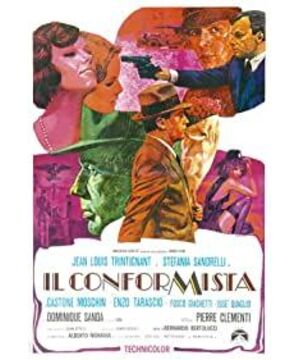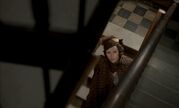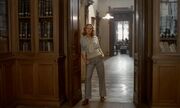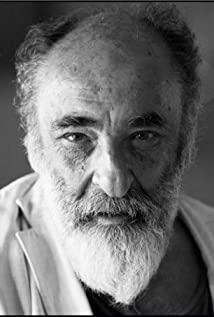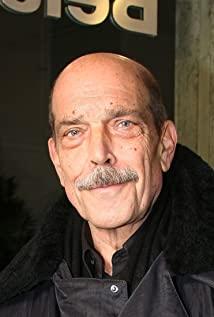Although the story of this film is relatively simple, there are deep meanings and symbols behind every film element. Not only in the details of the scene, but also in the character setting and narrative structure throughout the story.
The protagonist Marceno, the down-and-out child of the Italian nobility, and the child of the bourgeoisie and aristocracy, is a fascist, referring to the historical background and economic and social conditions produced by the phenomenon of fascism.
His father was a lunatic, living in a lunatic asylum, and he was talking about killing and domination. In Western culture, his father symbolized authority, order, and power, which can be interpreted as the history of fascism flourishing and declining authority.
His mother enjoys the mansion left by her father, but her private life is chaotic and promiscuous. His mother symbolizes the national culture and social status quo, which can be understood as the emptiness and chaos of the social spirit.
Both parents refer to the historical and social factors in which the fascist movement breeds.
When the protagonist Marceno was young, a gay driver seduced him, and used a concrete gun to trigger his madness and crime. The gay driver can be understood as a sudden, accidental, and irrational inducing factor. The means are violence and desire.
Marceno’s wife and mother-in-law are simple and secular, and symbolize the ordinary working people. The mother-in-law obeyed and defended Marceno, which shows that the beginning of the fascist movement was supported by the people, especially the bottom people. The wife’s sweet talk before marriage and the violent deception and exploitation after marriage just confirmed the change in attitude towards the general public after the rise of the fascist movement—from exploitation and coaxing to oppression and destruction.
Marceno prayed to the priest in the church. The priest symbolized morality and faith. The priest does not blame the sins committed by Somarcino, but is entangled in whether he prayed to God or not. This can be understood as the intention conveyed by the author-morality is trapped in itself, not against the facts. . The priest’s weakness is also manifested in the face of brutality and power, and the weakness of moral beliefs.
There is also a detail. The lawyer who was the witness of the wedding seduced Marceno's wife and slept for six years. This also shows that the law itself is illegal, and that the law itself is a guise and accomplice of crime.
The professor who was responsible for investigating and harming Marceno was a teacher who taught him personally, which can be understood as the inheritance of virtue, reason and thought with the characteristics of classicism. Fascism was born out of European social doctrines and subverted the inherent class thesis, but advocated that young and middle-aged people overthrow the elderly. The Plato cave they talked about was also a mapping and probing into the subject of the film.
As for the professor’s wife, it is a symbol of Marceno’s beautiful lover. It can be understood as the nihilistic goal and direction set by the fascist movement. In the end, the professor’s wife was buried in the hands of Marceno, which also symbolized the fascist movement. The beauty destroyed.
As for Marceno’s superiors, liaisons, and accomplices, they refer to another characteristic of the fascist movement—not a personal free movement, but a mutually encumbered, choiceless and irreversible system mechanism. The sway during Marceno's period can be seen as the contradictions and confusions of the participants of fascism.
In the end, fascism, born in an environment of anxiety, fracture, and economic collapse, appeared and grew under the temptation of desire and power, using violence as a means. It has won the support and support of the general public and the people at the bottom. It makes more use of the public but its own status is consolidated. In this state, morality and beliefs are hypocritical and overwhelming. Law and order themselves have become accomplices of atrocities and movements, unknowingly transforming the people from supporters to enslaved status. The classical morality and thought were destroyed. The movement towards a dead end also contains contradictions and conflicts. At the same time, it also destroys the beautiful original intentions of the fascist movement and the early achievements it has obtained. And when all incidents were revived in the chaos, the former perpetrators of the atrocities and the participants of the fascist movement changed their own crimes completely, and instead used other factors that lured them.
In fact, this film not only points to the fascist movement, it is also suitable for the chaotic 1960s, the earlier French Revolution and the anarchist movement, and even for the current China. It is precisely because of this that the film is actually exploring the operating mechanism and principle analysis of human society. But all this meticulous logic is hidden in the seemingly ordinary but actually well-designed film narrative full of metaphors.
In fact, every scene and every action can extend a lot of content, and the master is really awesome.
. . . . . . . . . . . . . . . . . . . . . . . . . .
As a kid Li Yishu who came up with this without beginning and ending after watching for 40 minutes, I am still very pleased.
View more about The Conformist reviews


